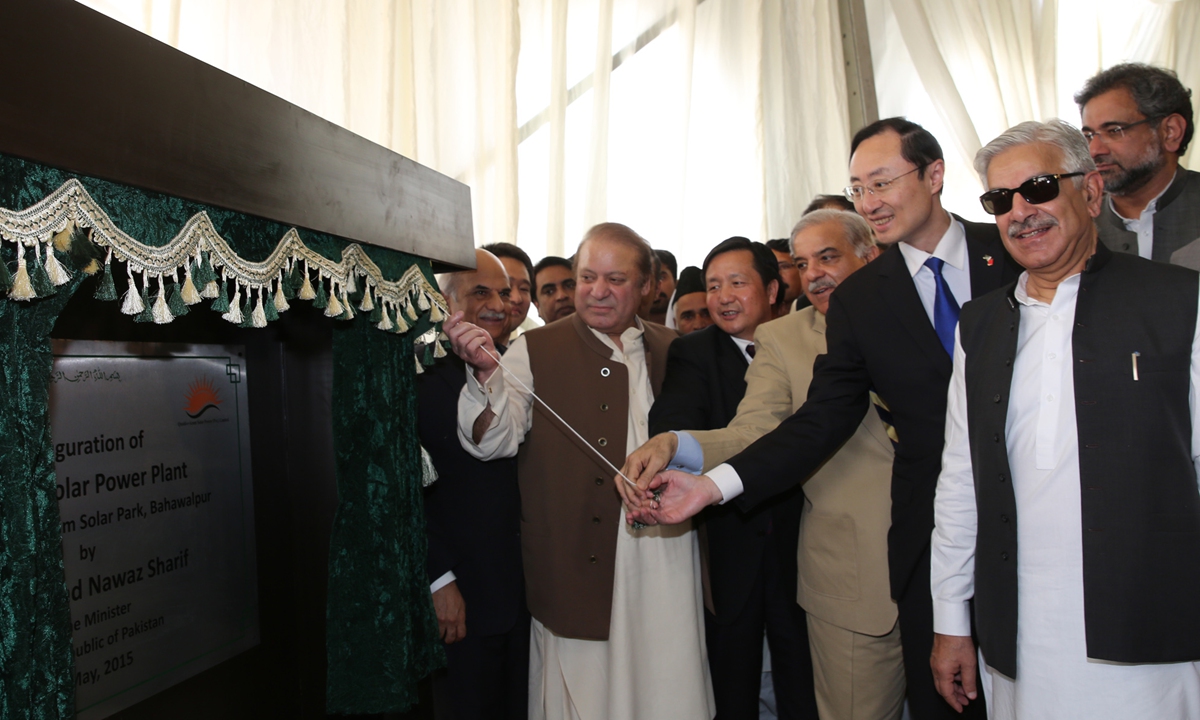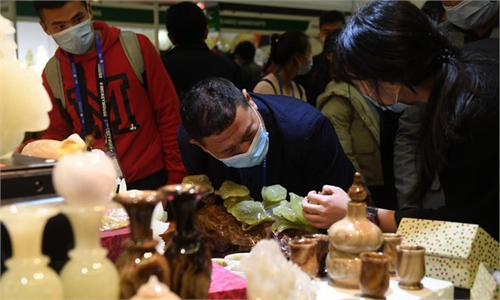
A general view of a Chinese company constructed solar power plant in Pakistan Photo: Cnsphoto
A number of renewable energy projects backed by Chinese firms have blazed a trail across countries linked to the Belt and Road Initiative (BRI), propelling a green transformation as the global community seeks a more sustainable recovery in wake of the economic onslaught of the COVID-19 pandemic which has caused global energy demand and investment to shrink.
Energy cooperation has always been a key component of the BRI. China and partnering countries have worked together on a long list of energy projects ranging from fossil fuel-based power plants to clean energy projects focused on wind, solar, and hydro, and even nuclear power. These projects are often seen as critical infrastructure aimed at tackling local power shortages and laying groundwork for future industrial development.
With the world shifting toward greener sources of energy, renewable energy projects are increasingly winning praise from observers and the media.
Examples of green development
In Malta, a country of half a million residents located in the middle of the Mediterranean Sea boasting an annual intake of 3 million tourists, a Chinese power company has helped the country to transform its energy mix from "dirty electricity" built on inefficient, unsustainable diesel to cleaner natural gas, through constructing a new LNG power-plant.
The new plant, built by the Shanghai Electric Power Co (SEP), supplies power at a cheaper rate and is much more reliable than the old plant, according to John Aquilina, Ambassador of Malta to China, at an energy forum on Thursday.
Cooperation between the Maltese government and SEP did not stop there with work immediately beginning on a new solar power that puts the tiny island country at the top among EU members in terms of the proportion of solar power as part of its energy mix.
Malta, once at the mercy of expensive diesel power generation which provided a highly unstable supply of electricity, has now set its eyes upon becoming an energy exporter in the region, and SEP has set up a Malta holding company based on the island country to make market inroads into other countries across Europe and North Africa.
Other projects coming online include a wind farm in Montenegro which generates clean energy, and now accounts for three percent of total power use in the Balkan state. There are also plans to provide surplus energy exported to nearby Italy and North Africa.
The Maltese ambassador said the success of the SEP partnership, which is already reporting a profit only five years after the project started, could act as an example to other Chinese companies seeking to do business in the EU. Notably, success was achieved even against the backdrop of an EU trade dispute with China over solar panels.
"Through our cooperation under the BRI with China, we have been able to meet EU standards more effectively by providing cleaner energy while also lowering gas emissions. That is what the EU wants," Aquilina told the Global Times on Thursday, hailing the endeavor as a win-win.
Malta is not alone. In Pakistan, a number of renewable energy projects, including the massive Quaid-e-Azam solar park and the Karot hydropower station, highlight the China-Pakistan Economic Corridor's harnessing of green energy.
Marking a further milestone, the country also became one of the few developing nations in the world to make progress toward clean energy leveraging third-generation nuclear reactor technology, made possible by China's Hualong One nuclear technology.
At the country's Karachi 2 reactor, designed by the China National Nuclear Corp, the process of loading fuel assemblies into the core has already begun as of late November.
In Abu Dhabi, UAE, leading Chinese solar firm JinkoPower has partnered with several foreign energy firms to build the world's largest single-project solar power - the Al Dhafra project with a capacity of 2 gigawatt.

Former Prime Minister Nawaz Sharif (second from left) attends the opening ceremony of a Chinese company built solar power plant in Bahawalpur, Pakistan on May 5, 2015. Photo: Cnsphoto
Green opportunitiesChina's renewable energy investment in countries and regions associated with the BRI has been above $2 billion each year over the life of the BRI program and is gradually rising, according to the National Energy Administration of China.
China is also moving toward a high-quality and more sustainable energy development model, taking a global lead. The country announced in September an ambitious plan to achieve carbon neutrality before 2060.
China's total installed capacity for renewable energy accounted for over 41 percent of its total energy mix as of October, completing the world's largest clean energy power system that includes the world's largest hydro, wind, and solar network, said Lin Shanqing, Vice Administrator of National Energy Administration at the 2nd Belt and Road Energy Partnership Forum on Thursday.
The transformation has taken place as over 120 countries around have rolled out targets for zero greenhouse gas emissions or agendas to realize carbon neutrality, boosting the development of a global new energy industry.
Munteha Jemal, minister of Ethiopian Embassy in China, said that the East African country has identified manufacturing as a priority area for investment and the development of power has also become a must.
"Without power, it is impossible to win foreign direct investment," Jemal told the Global Times on Thursday, noting that a number of power projects are in process to help add the country's energy capacity by 20,000 megawatts.
Although Ethiopia has traditionally relied on hydro power installations, the country is also looking at expanding power generation capacity from solar, wind and biomass, all well suited to local conditions, the diplomat said.
Chinese energy experts and industry insiders have said that while many countries hold ambitious goals in pursuing renewable and clean energy, they face hurdles in raising funds, securing loans, equipment manufacturing and sourcing expertise. China through the BRI holds the experience and resources to make many of these goals a reality. In short, cooperation is fundamental to creating a greener world.
As of 2019, Chinese companies have invested over $100 billion in energy projects in BRI markets.
Participating countries in the BRI are considering proposing a green energy development initiative raised during a forum for BRI energy ministers in 2021, this would also include setting priority development goals and drawing a roadmap to center green energy a major driving force in the global economic recovery in the wake of the pandemic.


